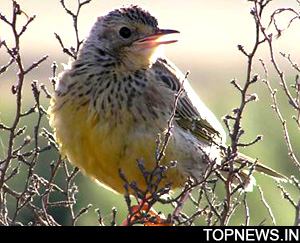African lark may soon become extinct
 London, April 16 : A recent survey has found that just a few hundred of the African larks survive in Ethiopia, which indicates that the endangered bird might soon become extinct.
London, April 16 : A recent survey has found that just a few hundred of the African larks survive in Ethiopia, which indicates that the endangered bird might soon become extinct.
According to a report by BBC News, if and when it happens, it may be the first recorded bird extinction on the African continent, and it would not be the last.
"This imminent extinction reflects a wider social and political crisis that is repeated throughout Africa," said zoologist Claire Spottiswoode of the University of Cambridge, who led a survey of the bird's habitat and published her findings in the journal Animal Conservation.
The Sidamo lark (Heteromirafra sidamoensis) is an enigmatic species, and one of the most ancient types of lark known anywhere.
The birds inhabit a very small pocket of grassland within the Liben Plain of southern Ethiopia. Discovered by scientists in 1968, the bird was only seen once in the following 25 years.
"If we lose this species then we lose an important ancestral link in the evolution of the entire radiation of lark species," said Dr Spottiswoode.
Dr Spottiswoode surveyed the Liben Plain with colleagues from the Ethiopian Wildlife and Natural History Society, Birdlife International and the University of East Anglia.
They found that the Sidamo lark lives within a single patch of grassland of just 35 square kilometres.
Bush encroachment and agriculture has damaged the lark's unique habitat.
That compares to a range of 760 square kilometers estimated by Birdlife International just last year, though that was a rough guess based on the best information available at the time.
"The Liben Plain has recently much diminished in size owing to bush encroachment and crop planting. Much of the remaining grassland is too degraded for the species to exist in it," said Dr Spottiswoode.
Worse, the survey revealed that a maximum of 358 Sidamo Larks remain.
More likely, between 90 and 250 of the birds survive. "Even the lower value might be optimistic," according to the authors of the study.
They have recommended to the International Union for the Conservation of Nature (IUCN) that it upgrades to the bird's status to "critically endangered".
To save the bird from imminent extinction, conservationists have recommended the creation of small plots in which cattle could graze. That would stop damage to the grassland and maintain the grass cover required by breeding females.
Shrubs should also be removed, while a limit should be placed on crops expanding further into the bird's range. (ANI)